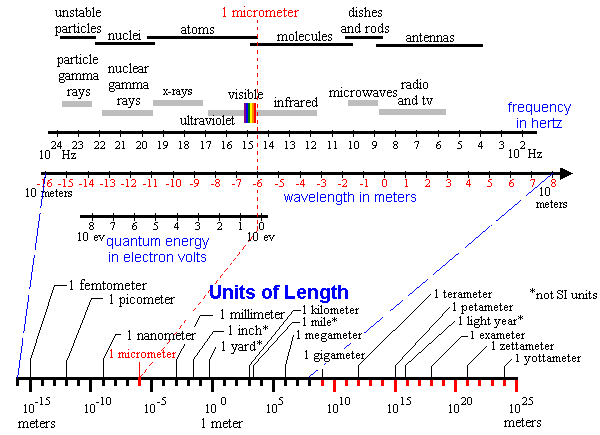Logarithmic ScalesThe chart below is designed to show the basic physical relationship between energy and electromagnetic radiation. A fundamental result of this relationship is that the smaller an object, the smaller is the wavelength of radiation required to form an image of it. Furthermore, the smaller the wavelength, the greater the energy required to produce it. This is why larger and more powerful accelerators are required to discover smaller and more energetic particles. The top row of bars indicates the source for electromagnetic radiation of a particular frequency range. The second row of bars gives the name associated with a specific range of frequencies. The next three lines are the three related scales of frequency, wavelength, and energy. The bottom scale provides the names of some commonly used units along the distance scale. Electromagnetic radiation with a wavelength of one micrometer, lies just redward (longer wavelength) of what the eye can see. It has a frequency of 3.00 x 1014 hertz and a quantum energy of 1.24 electron volts. This single example will fix the relation between the three scales, for frequency is strictly proportional to quantum energy and inversely proportional to wavelength. (The wavelength scale--and other red markers--can be used to jump to the appropriate power of ten.) Some Words About UnitsI have used the International System of Units (SI) throughout these pages--with some occasional exceptions. My intent is to be as accurate and consistent as possible while reaching a wide and varied audience. I hope to entertain, and possibly enlighten, nonscientists and scientists alike. For a thorough discussion of the International System of Units, check out the U.S. Metric Association. In particular:
The light year is not accepted as an SI unit. The speed of light in a vacuum is nearly 3 x 108 m/s. In one year, light travels approximately 10 petameters, or 1016 meters. The light year is used in astronomy as a measure of distance -- the distance that light travels in one year. The unique advantage of the light year is that it relates distance to the passage of time. When observing a galaxy that is 1 billion light years from Earth, we are seeing that object as it was 1 billion years ago because the light has taken that long to reach us. This is an important concept in considering the evolution of the Universe. The objects that we see at cosmological distances are younger than closer objects. For this reason I have continued to use the light year in these pages. The orbital distance from the Earth to the Sun is defined as an astronomical unit (AU) and is approximately 150 Gm. Thus 1 light year is equal to about 67 000 AU. Copyright © 2016 by Bruce Bryson |
